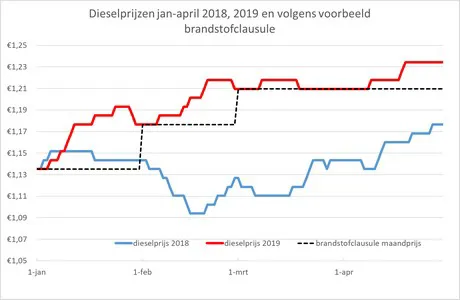A liter of diesel (BP, bulk consumption, excl. VAT) was 5.7% more expensive in the first four months of 2019 compared to the same period last year in the Netherlands.
Particularly in February, the diesel was much more expensive than a year ago. In April, the difference in price when compared to 2018 already was a bit smaller. And while the price of diesel quickly rose since March 2018, the diesel has remained the same since March this year.

544 more spent than last year
What does an average price increase of 5.7% mean in practice? A transporter with a truck that drives 100,000 kilometers per year on average, with an average use of 1 in 4, paid 544 euros more in the first four months when compared to 2018. Of course, this varies per situation, per vehicle, and per transport company.
Fuel clauses
Some transport companies apply fuel clauses to prevent a strong increase in the diesel price to have a large impact on the profits. The so-called reference price (the price you base the calculation on) and the period it applies to, play an important role in such clauses. There are many different kinds of fuel clauses. In one variant, the diesel price on the first day of the month is the reference price for that entire month. This would mean a large disadvantage for a transporter in the first two months: the diesel price kept rising after the first day of the month. In March and April, the consequences were smaller, although the real price was higher than the reference price for a number of days. The calculation example shows that using a fuel clause is one thing, but that the formulation is even more important because it determines the effectiveness of the clause.
Fuel saving
In an analysis of the total fuel costs, you should not only look at the price of a liter of diesel, but also at the number of liters bought. Have more or fewer kilometers been driven? Or has the fuel use increased by, for example, more traffic or less economical driving?
Source: TLN
